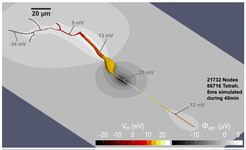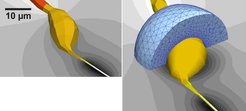Bilingual Neurons
Nerve cells in the brain speak two „languages“. A new computer simulation package for the first time accounts for both methods of communication.
The brain is densely „populated“ with specialized nerve cells; there are about 100 000 of these “neurons” in a single cubic centimeter of brain tissue. This means that the distance between two neighboring cells can be as little as a thousandth of a millimeter. Nevertheless, we generally assume that each neuron is insulated from its neighbors, communicating with other neurons only through the specific connections its long axon makes. But what about the electrical fields that each nerve cell generates around it, which could be directly perceived by its closely packed neighbors? Scientists from the Max Planck Institute for Dynamics and Self-Organization (MPIDS), the Bernstein Focus Neurotechnology, and the University Hospital in Göttingen (Germany) are now studying the potential impact of such direct inter-cell interactions. They have now developed a new physical model which examines the electric fields each neuron produces in the actual brain. They have implemented this new model in a computer simulation package, which is now widely available as open source software.
Both the United States and the European Union have just announced major initiatives for Brain Research in the coming years. The American government plans to invest several billion dollars in a “Brain Activity Map Project” and the European Commission decided to support a billion Euro “Human Brain Project” led by the Eidgenössische Technische Hochschule in Lausanne (Switzerland). “We contend that projects like these can only be truly complete, if they consider all forms of nerve cell interaction, including those influences each neuron contributes to the local electrical field”, says Dr. Andreas Neef, a neurophysicist at the MPIDS. He is head of a new research group “Neuronal Computation” at the Bernstein Center for Computational Neuroscience in Göttingen.

A snapshot of neuronal activity: The new software calculates what happens when a neuron sends an electrical signal along its axon. The voltages created in the membrane are depicted in colors ranging from black to yellow. The shades of grey show the strength of the electrical fields outside the cell.
“Neurons influence each other via both highly specific connections and through undirected mechanisms“, Dr. Andres Agudelo-Toro from the MPIDS explains. “It is almost, as if they communicated in two different languages”, he adds. Specific connections create neural circuits that can involve brain areas that are far apart – even on the other side of the brain. However, every time a neuron produces an electrical impulse that travels to distant sites, it also produces a weak electrical field which influences other cells in it direct vicinity. These field effects, which contribute to the well known electroencephalogram (or EEG), can help to synchronize the activity of the neurons in particular regions of the brain, but have heretofore been ignored in almost all schemes of neuronal computation.
One reason that field effects have not been considered in the past has been the technical difficulty to realize the problem in the computer. “When we began studying the interaction of neurons in simulations, we came to realize that no suitable numerical tools were available”, says Agudelo-Toro. “One reason is that until now, simulating even a simple scenario is such a complex computational problem that it could require up to several weeks.” By employing especially efficient mathematical methods and splitting the workload between several processors, the Göttingen researchers are now able to simulate realistic scenarios using only a few hours of computer time. “We have created a tool that is able to model various processes and situations in the brain realistically”, says Neef.

Since the new software is of great value for medical applications, researchers from the German Primate Center and the University Hospital in Göttingen are adopting the new software in collaboration with Neef’s group.
The scientists from Göttingen have named the program “CHASTE-Membrane”. It is offered as open source software at http://www.cs.ox.ac.uk/chaste/download.html . It is an extension of the project CHASTE (Cancer, Heart, and Soft Tissue Environment) at the Department of Computer Science of the University of Oxford.

